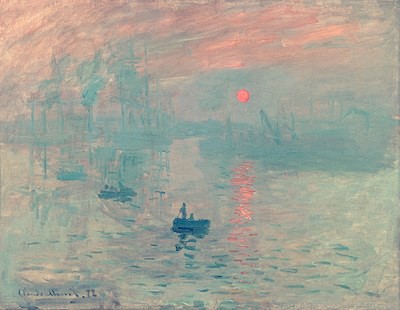April 29, 1874. Impression: Soleil Levant. A sunrise painted two years before in the Havre harbour.
Except there was no sunrise on the canvas, but a fuzzy combination of blue, gold, and crimson. A feeling of sky and water.
Jules-Antoine Castagnary, “L’exposition du boulevard des Capucines- Les impressionnistes,” Le Siècle 1874
‘The small floating boats and figures are suggested rather than carefully detailed. There is no linear perspective, no true foreground, middle or background. The entire scene appears flat. The canvas surface is textured; you can see the tiny ridges where the artist lifted his brush. This is not a landscape …”
No. It is an impression.
There, on the wall, in a frame, was a feeling, the sensation one would have, standing at the harbour, looking onto the water, watching the sun rise on that day. Nothing would be clear, the detail lost in atmospheric haze, the colours and shapes blurred by the light, itself fleeting, transitory.
The painting sparked uproar. This was not real! critics cried. The artist agreed; Claude Monet had not intended to paint reality. Nor had he intended to paint a dream; no sea gods or allegories, no grand battle ships. Those were fishing boats and labourers, one random morning.
He had painted life, not as it was or as it was supposed to be. Life as he saw it, as art. Life simply being lived,
but in a hundred, thousand infinite moments of colour and light and wind.
Around Monet and the world, at that time, others were discovering the telephone, rocket science, explosives, the internal combustion engine, aviation, transportation, vaccines, and evolution. Capitalism and socialism. That God was dead and that man could live forever in a photograph. He had discovered that there could never be two identical sunsets.
Monet spent his life thirstily watching the light change on waterlilies, haystacks, and poppy fields, capturing moments, impressions, feelings, in his paintings. Castagnary called him, his peers, and their work ‘impressionist:’ unfinished and imperfect. It was. Like this life they madly loved.
A painter of life is a flâneur, completely non-utilitarian. The one person in a crowd, walking, not to get anywhere. Who strolls, looks around, and sees everything, every time, for the first time. Like a convalescent, or adolescent who has just learned to make love.
Suddenly, through the kaleidoscope, the grey morning fumes, biting cold, paint peeling off the haggard fishing boats, sun rising on the harbour, become a picture ‘more living than life itself.’ Impression.
A painter of life is someone who knows it but is not cynical, loves it but is not naïve, notices the light and colours change on a pond of waterlilies.
Someone who is ‘a seeker of consciousness and an agent for understanding in the modern world’…
Someone who is, like this blog, completely non-utilitarian.
